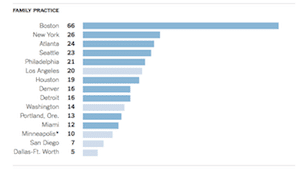The Marketing and Financial Advantages of Prompt Medical Appointments
 The American public has been conditioned to think that they get medical appointments “quickly,” but, more often than not, it’s not true. In many areas the average wait time for new patients is a matter of weeks and sometimes months.
The American public has been conditioned to think that they get medical appointments “quickly,” but, more often than not, it’s not true. In many areas the average wait time for new patients is a matter of weeks and sometimes months.
It’s an uncomfortable healthcare trend. For some people, a long wait for a doctor appointment is the accepted standard. But the silver lining here is that a medical practice that can provide a near-immediate appointment gains important business, financial and competitive marketing advantages.
Considering the data from a recent Merritt Hawkins survey, your competition may be vulnerable. To illustrate, the average wait in days (including Saturdays and Sundays) for a Family Practice appointment is 66 days in Boston, 26 days in New York, and 24 days in Atlanta.Boston also leads the list, reported in an in-depth New York Times article, in other categories. For an Obstetrics/Gynecology appointment it’s a 46-day average wait time, and for a Dermatology appointment the average wait will be a matter of months; 72 days in Boston, 56 days in Minneapolis.
The survey data [2013 chart] looked at five kinds of appointments in 15 metropolitan areas. And compared with data from the previous survey in 2009, many of new patient wait times are increasing.
Opportunity lost…
The marketing downside to this picture is troubling. Societal behavior is rapidly trending toward immediate answers, prompt solutions and instant information. Waiting weeks for an appointment was an “acceptable norm” of the past, but the empowered patient-consumer of today wants prompt attention for their health care.
An extended wait for an appointment—particularly for a new patient appointment—includes an increasingly likely risk that the patient will shop for a more attractive option, and then head over to the competition.
And, if another physician referred the patient, a lengthy pause or delay can disappoint (and possibly alienate) the referral source. For each patient lost, a primary care doctor loses at least $1,600 in revenue…often more. And a lost referral source can mean hundreds of thousands of dollars in unrealized revenue.
How does your office stack-up against the averages on this chart? Every doctor’s office should know the number of days, on average, that a new patient will wait to be seen. Having an established metric, and working to achieve and maintain a low number, has several benefits, including:
- Improve quality and clinical outcomes
- Enhance financial and operational efficiency
- Delight patients and enhance patient experience
- Extend patient retention and loyalty
- Improve the quality and timeliness of patient care
- Improve physician and staff productivity and satisfaction
And from a medical practice marketing perspective, prompt, same day, or next business day appointments effectively differentiate the practice from the competition; patient satisfaction inspires referrals, and the overall practice reputation is enhanced.









